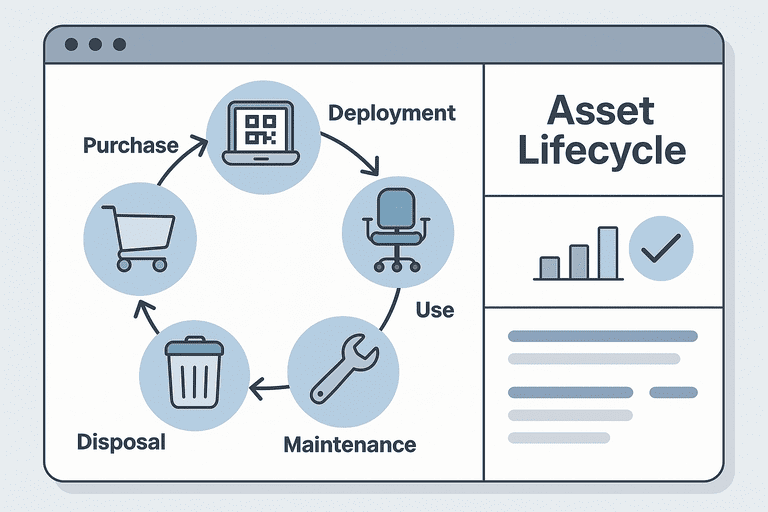The Anatomy of an Asset Lifecycle: From Purchase to Disposal
Understand each stage of the asset lifecycle—from acquisition and usage to maintenance and disposal—and learn how to manage assets efficiently at every step.

Introduction
Every asset in a business—whether a laptop, vehicle, or piece of furniture—has a journey. It begins with a purchase and ends when it’s retired or disposed of. Managing this asset lifecycle effectively ensures that organizations get the most value out of their investments while maintaining compliance, accuracy, and operational control.
This article breaks down the key phases of an asset’s life and provides practical guidance for each—from acquisition and tracking to maintenance, audits, and responsible disposal.
1. What Is the Asset Lifecycle?
The asset lifecycle represents all stages that an item goes through during its existence in a company. It is a closed loop of activities that help organizations track:
- How much an asset costs
- Who uses it and where it is located
- When it requires service or replacement
- How it is disposed of responsibly
Effective lifecycle management provides financial transparency, supports audits, and ensures sustainability through informed replacement and recycling decisions.
2. Stage 1 — Acquisition and Planning
The lifecycle begins before the purchase.
Strategic acquisition involves understanding what’s needed, why it’s needed, and how it will be used.
Key actions:
- Forecast asset demand based on team size, projects, or operations.
- Set procurement budgets and approval workflows.
- Define asset categories (IT, furniture, vehicles, machinery).
- Capture vendor data and purchase documentation.
Common pitfalls:
- Over-purchasing due to unclear requirements.
- Lack of standardization (different models, vendors).
- Missing warranty and maintenance details at acquisition.
Best practice:
Establish an approval process that captures not only cost and supplier data but also the intended lifespan and expected utilization of each asset.
3. Stage 2 — Deployment and Assignment
After purchase, the asset moves into the operational environment. It’s assigned to a person, department, or physical space.
Tasks to perform:
- Tag each asset with a unique identifier (QR code, barcode, or RFID).
- Record details: user, department, location, and serial number.
- Log any accessories or bundled items.
- Capture setup and configuration data for IT assets.
Why it matters:
Proper deployment ensures traceability from day one. Missing this step often leads to untracked items, misplaced equipment, and accountability gaps during audits.
4. Stage 3 — Active Use and Maintenance
This is the longest phase of the lifecycle—the period when the asset generates value through use.
Best practices:
- Schedule preventive maintenance based on usage or time intervals.
- Log all service activities, spare parts, and technician visits.
- Record incidents like damage or loss.
- Monitor asset utilization to identify underused or overworked resources.
Maintenance records help extend lifespan and justify future investments.
Common indicators for maintenance scheduling:
- Operating hours (for machinery)
- Mileage (for vehicles)
- Device uptime and failure rates (for IT equipment)
Regular checks reduce unplanned downtime and preserve asset reliability.
5. Stage 4 — Auditing and Compliance
Audits verify whether records match reality. This phase can happen periodically throughout the asset’s life.
Audit types:
- Physical audits: verifying tagged assets against records.
- Cycle counts: small, recurring audits on asset subsets.
- Financial audits: reconciling depreciation and book value.
- Compliance audits: ensuring safety, environmental, or data regulations are met.
What to document:
- Current condition
- Last known location
- Assigned user or department
- Verification timestamp
Maintaining audit trails ensures accountability and reduces risks during external inspections or certifications.
6. Stage 5 — Depreciation and Financial Tracking
As assets age, their value decreases.
Accurate depreciation tracking supports financial reporting, insurance valuation, and tax deductions.
Popular depreciation methods:
- Straight-Line: equal value loss each year.
- Declining Balance: accelerated value loss early in lifespan.
- Usage-Based: tied to hours, mileage, or production volume.
Depreciation records should align with accounting policies and asset type. Misaligned schedules lead to distorted valuations and compliance risks.
7. Stage 6 — Renewal, Reassignment, or Retirement
Eventually, every asset reaches a decision point: keep, repair, replace, or dispose.
Evaluation checklist:
- Does the asset still meet performance needs?
- Is the maintenance cost higher than replacement value?
- Can it be reassigned to another team?
- Are there environmental or data risks if retired?
For IT or electronic devices, always follow data sanitization and eco-friendly disposal practices (e.g., WEEE compliance in the EU).
Possible outcomes:
- Renewal: extend life through upgrades or maintenance.
- Reassignment: shift asset to another department.
- Disposal: retire and document end-of-life.
Properly closing the lifecycle ensures no “ghost assets” remain on your books.
8. Continuous Lifecycle Optimization
Lifecycle management shouldn’t be static.
Regularly review metrics to improve decisions:
- Utilization rates — identify underused assets.
- Repair vs replacement ratios — control costs.
- Average asset age — monitor modernization needs.
- Audit accuracy — measure data reliability.
Modern inventory systems automate much of this, ensuring every lifecycle event—from purchase to disposal—is tracked, timestamped, and reportable.
Conclusion
The asset lifecycle is the backbone of operational efficiency.
By understanding each stage—acquisition, deployment, use, audit, and disposal—you can create a continuous improvement loop that reduces costs, prevents loss, and supports compliance.
Managing assets isn’t only about ownership—it’s about visibility, responsibility, and timing.
Explore related topics to strengthen your lifecycle management process: